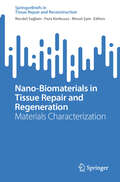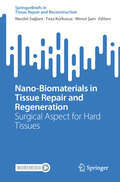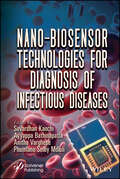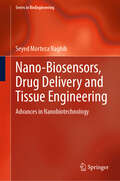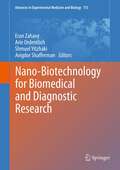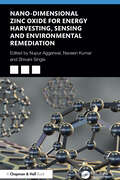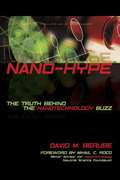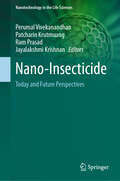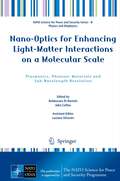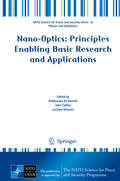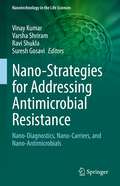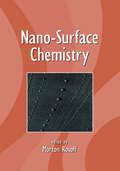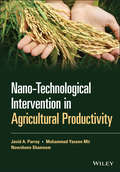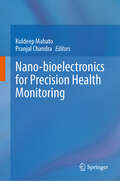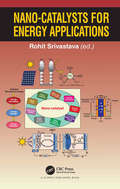- Table View
- List View
Nano-Biomaterials in Tissue Repair and Regeneration: Materials Characterization (Tissue Repair and Reconstruction)
by Feza Korkusuz Necdet Sağlam Mesut ŞamThis book covers the characterization of nano-biomaterials in tissue repair and regeneration which are materials designed to interact with biological systems to restore and regenerate damaged tissues. These materials serve as scaffolds that mimic the natural extracellular matrix (ECM), providing structural support and biochemical cues necessary for cellular activities. The physical and chemical properties of biomaterials are tailored to specific applications, such as bone regeneration, cartilage repair, wound healing, and organ transplantation. Biomaterials influence cell behavior and tissue formation by controlling factors like mechanical strength, porosity, and surface topography. This book provides an overview of the topic from the biomaterials’ characterization point of view and is suitable for students, academics, and clinical practitioners who are interested in the advancements of regenerative medicine.
Nano-Biomaterials in Tissue Repair and Regeneration: Surgical Aspect for Hard Tissues (Tissue Repair and Reconstruction)
by Feza Korkusuz Necdet Sağlam Mesut ŞamThis book covers the clinical application of nano-biomaterials in hard tissue repair and regeneration which are materials designed to interact with biological systems to restore and regenerate damaged tissues. These materials serve as scaffolds that mimic the natural extracellular matrix (ECM), providing structural support and biochemical cues necessary for cellular activities. The physical and chemical properties of biomaterials can be tailored to specific applications, such as bone regeneration, cartilage repair, wound healing, and organ transplantation. Biomaterials influence cell behavior and tissue formation by controlling factors like mechanical strength, porosity, and surface topography. This book is suitable to students, academics, and clinical practitioners who are interested in the advancements of regenerative medicine.
Nano-Biosensor Technologies for Diagnosis of Infectious Diseases
by Anitha Varghese Suvardhan Kanchi Ayyappa Bathinapatla Phumlane Selby MdluliThe book offers a thorough exploration of revolutionary nano-biosensor technologies that enables rapid, accurate detection of infectious diseases, critical for effective disease management in today’s world. Nano-Biosensor Technologies for Diagnosis of Infectious Diseases delves into the cutting-edge developments in nano-biosensor technology, a transformative innovation for the field of medical diagnostics. Nano-biosensors integrate nanomaterials like nanoparticles, nanowires, and nanotubes with biological recognition elements such as antibodies, nucleic acids, or enzymes to create highly sensitive and specific detection systems. These sensors exploit unique properties of nanomaterials to detect minute quantities of pathogens or biomarkers with remarkable accuracy, enabling early diagnosis and monitoring of infectious diseases. The integration of electrochemical, optical, and piezoelectric detection mechanisms further enhances the versatility and efficiency of these nano-biosensors, allowing for rapid, real-time analysis that is crucial for effective disease management. In the context of infectious diseases, nano-biosensors become particularly significant, as they can facilitate point-of-care testing (POCT), offering rapid and portable diagnostic solutions. This capability is invaluable in resource-limited settings and during outbreaks where traditional laboratory infrastructure may be lacking. The COVID-19 pandemic underscores the importance of swift and accurate diagnostic tools, spurring accelerated innovation and commercialization efforts in this domain. Nano-biosensors are now being developed and deployed to detect a wide range of pathogens with high sensitivity, providing a powerful tool in the global fight against infectious diseases. Nano-Biosensor Technologies for Diagnosis of Infectious Diseases provides a comprehensive overview of these technological advancements, exploring their applications, challenges, and future directions in the diagnosis and management of infectious diseases. Audience Biomedical engineers, material chemists, researchers, students, policymakers, and healthcare professionals interested in integrating nanomaterials in infectious disease care
Nano-Biosensors, Drug Delivery and Tissue Engineering: Advances in Nanobiotechnology (Series in BioEngineering)
by Seyed Morteza NaghibThis book highlights a novel combination of nanotechnology and biotechnology enabling the practical use of conventional microtechnology in conjunction with a molecular approaches in cancer detection and treatment. As nanotechnology and biotechnology have advanced, the methods such as nanoimaging, nanobiosensing, nanolabeling, nanodiagnostics, and nanotherapeutics have developed. The pricey old manufacturing process will be replaced by the new expanding field of nanobiotechnology, which will produce durable, flexible, and accurate devices at a lower cost and with less environmental impact. Drug distribution, sensor systems, small robots, and surgical instruments might all benefit from the development of stronger materials made possible by this technique. Nanobiotechnology may be used to create atomic grade machines by merging or simulating biological processes or creating tiny tools to alter many aspects of the living system at the molecular level. This book presents a state-of-the art technology that enhances our existing knowledge and ideas integrating chemistry, physics, and biology. The book discusses a number of cutting edge medical technologies that use nanoparticles as delivery or sensing systems are examples of nanobiotechnology as they employ nanotechnology to further biological objectives.
Nano-Biotechnology for Biomedical and Diagnostic Research
by Arie Ordentlich Avigdor Shafferman Eran Zahavy Shmuel YitzhakiThe title "Nano Biotechnology for Biomedical and Diagnostics Research" will address research aspects related to nanomaterial in imaging and biological research, nanomaterials as a biosensing tool, DNA nanotechnology, nanomaterials for drug delivery, medicinal and therapeutic application and cytotoxicity of nanomaterials. These topics will be covered by 16 different manuscripts. Amongst the authors that will contribute to the book are major scientific leaders such as S. Weiss - UCLA, I. Willner, and G. Golomb - HUJI, S. Esener - UCSD, E.C. Simmel - Tech. Univ. Munchen, I. Medintz - NRL, N. Hildebrandt - Université Paris and more. The manuscripts in the book intend to present specifically biological, diagnostics and medical problems with their potential solution by nano technology or materials. In this respect this book is unique, since it would arise from the biological problems to the nano technology possible solution and not vice versa.
Nano-Dimensional Zinc Oxide for Energy Harvesting, Sensing, and Environmental Remediation
by Naveen Kumar Nupur Aggarwal Shivani SinglaZinc oxide (ZnO) nanostructures have gained significant attention in recent years due to their applications in various fields. The book provides a comprehensive overview of the recent advances in ZnO-based nanostructures for energy harvesting, sensing, and environmental remediation applications. It covers advanced aspects of application-based research on ZnO nanostructures. The book also includes biosynthesized ZnO nanostructures and their role in targeted drug delivery.Features: Explores various synthesis techniques for ZnO nanostructures, detailing their impact on material properties and applications in emerging technologies Discusses the role of ZnO- based nanostructures in solar cells, photocatalysis, and environmental remediation, including heavy metal detection and removal Highlights ZnO nanostructures’ potential in electrochemical sensors for med-ical diagnostics, antimicrobial applications, and gas sensing technologies ZnO’s piezoelectric properties, ultraviolet photodetectors, and its integration into next-generation electronic and optoelectronic devices are discussed in depth Provides insights into ZnO nanostructures role in plant growth enhancement, along with discussions on future research directions and technological advancements in the field This is a reference book for academicians and researchers interested in the potential of nano-dimensional zinc oxide.
Nano-Hype: The Truth Behind the Nanotechnology Buzz
by David M. BerubeNanotechnology, the science of molecular engineering at the atomic scale, has captured the popular imagination. From movies to TV series to video games, utopian fantasies and horror scenarios involving nanotechnology have become a staple of the entertainment industry. The hyperbole surrounding this new technology comes not only from the media but also from scientists who exaggerate the anticipated benefits of nanotechnology to justify research funding, as well as from environmentalists and globalization opponents, who sometimes indulge in doom-and-gloom prophecies to advance their own agendas. The result is widespread misinformation and an uninformed public. In an effort to set the record straight, professor of communication studies David M. Berube has written this thoroughly researched, accessible overview of nanotechnology in contemporary culture. He evaluates the claims and counterclaims about nanotechnology by a broad range of interested parties including government officials and bureaucrats, industry leaders and entrepreneurs, scientists, journalists, and other persons in the media. Berube appraises programs and grand initiatives here and abroad, and he examines the environmental concerns raised by opponents, as well as the government and private responses to these concerns. With so much argumentation on both sides, it is difficult for anyone to determine what is true. Nano-Hype provides up-to-date, objective information to inform the public. Based on over a decade of research and interviews with many of the movers and shakers in nanotechnology, this critical study will help the reader separate the realistic prospects from the hype surrounding this important cutting-edge technology.
Nano-Insecticide: Today and Future Perspectives (Nanotechnology in the Life Sciences)
by Ram Prasad Perumal Vivekanandhan Patcharin Krutmuang Jayalakshmi KrishnanIn recent years, nanotechnology has emerged as a promising tool for combating insect pests in agriculture, public health, and urban environments. Nanomaterials offer unique properties which can be leveraged to develop targeted and environmentally sustainable pest control solutions. However, despite growing interest in this area, there remains a need for a comprehensive resource that synthesizes the latest research findings and practical applications of nanotechnology for insect pest control. Nano-Insecticide addresses this gap by providing a thorough overview of the diverse applications of nanotechnology in insect pest management. The book covers a wide range of topics, including nanoparticles for insecticide delivery and release, nanostructured materials for pest monitoring and detection, nanobiotechnology approaches for pest-specific targeting, environmental implications, safety considerations and more. Case studies and practical applications from various agricultural and urban settings are also featured. Each chapter is authored by leading experts in their respective fields, ensuring that the book reflects the latest advancements and perspectives in nanotechnology for insect pest control. This book serves as a valuable resource for researchers, practitioners, policymakers, and students interested in the intersection of nanotechnology and pest management. By providing a comprehensive overview of the current state-of-the-art and future directions in the field, Nano-Insecticide aims to stimulate further research and innovation in this critical area. It has the potential to significantly advance our understanding and application of novel pest management strategies.
Nano-Optics for Enhancing Light-Matter Interactions on a Molecular Scale
by John Collins Luciano Silvestri Baldassare Di BartoloThis volume presents a considerable number of interrelated contributions dealing with the new scientific ability to shape and control matter and electromagnetic fields on a sub-wavelength scale. The topics range from the fundamental ones, such as photonic metamateriials, plasmonics and sub-wavelength resolution to the more applicative, such as detection of single molecules, tomography on a micro-chip, fluorescence spectroscopy of biological systems, coherent control of biomolecules, biosensing of single proteins, terahertz spectroscopy of nanoparticles, rare earth ion-doped nanoparticles, random lasing, and nanocoax array architecture. The various subjects bridge over the disciplines of physics, biology and chemistry, making this volume of interest to people working in these fields. The emphasis is on the principles behind each technique and on examining the full potential of each technique. The contributions that appear in this volume were presented at a NATO Advanced Study Institute that was held in Erice, Italy, 3-18 July, 2011. The pedagogical aspect of the Institute is reflected in the topics presented in this volume.
Nano-Optics: Principles Enabling Basic Research and Applications
by John Collins Luciano Silvestri Baldassare BartoloThis book provides a comprehensive overview of nano-optics, including basic theory, experiment and applications, particularly in nanofabrication and optical characterization. The contributions clearly demonstrate how advances in nano-optics and photonics have stimulated progress in nanoscience and -fabrication, and vice versa. Their expert authors address topics such as three-dimensional optical lithography and microscopy beyond the Abbe diffraction limit, optical diagnostics and sensing, optical data- and telecommunications, energy-efficient lighting, and efficient solar energy conversion. Nano-optics emerges as a key enabling technology of the 21st century. This work will appeal to a wide readership, from physics through chemistry, to biology and engineering. The contributions that appear in this volume were presented at a NATO Advanced Study Institute held in Erice, 4-19 July, 2015.
Nano-Strategies for Addressing Antimicrobial Resistance: Nano-Diagnostics, Nano-Carriers, and Nano-Antimicrobials (Nanotechnology in the Life Sciences)
by Vinay Kumar Varsha Shriram Ravi Shukla Suresh GosaviAntibiotics, the backbone of modern clinical-medicine, are facing serious challenges from emerging antimicrobial-resistance (AMR), a complicated phenomenon expanding in bacterial species, from nosocomial to community origins, where microbes are no longer sensitive to a range of commonly used antibiotics. AMR has exploded in recent years and is posing a serious threat to human health and survival. This necessitates novel and effective ways of diagnosis, drug-delivery, and treatment; nanotechnology and advanced nanomaterials are hailed as a potent solution in containing AMR.The main thrust of this volume is to explain the most current research on the central theme of potential use of nano-approaches for diagnosis, detection, drug-delivery and as antimicrobial agents against drug-resistant pathogenic microbes. This book provides an integrated blend of basic and advanced information for students, scholars, scientists and practitioners, interested or already engaged in research in these areas. We have brought together leading international authors to present and highlight various aspects of nanotechnology in combating AMR in WHO-prioritized microbes. Topics range from advances in nanomaterial synthesis, characterization, functionalization and improvisation, as well as applications in sensing, diagnosis of AMR, and their therapeutic and drug-delivery potential against MDR and XDR microbial phenotypes.
Nano-Structured Photovoltaics: Solar Cells in the Nanotechnology Era
by Vinod Kumar KhannaPresenting a comprehensive overview of a rapidly burgeoning field blending solar cell technology with nanotechnology, the book covers topics such as solar cell basics, nanotechnology fundamentals, nanocrystalline silicon-based solar cells, nanotextured-surface solar cells, plasmon-enhanced solar cells, optically-improved nanoengineered solar cells, dye-sensitized solar cells, 2D perovskite and 2D/3D multidimensional perovskite solar cells, carbonaceous nanomaterial-based solar cells, quantum well solar cells, nanowire solar cells and quantum dot solar cells. The book provides an in-depth and lucid presentation of the subject matter in an elegant, easy-to-understand writing style, starting from basic knowledge through principles of operation and fabrication of devices to advanced research levels encompassing the recent breakthroughs and cutting-edge innovations. It will be useful for graduate and PhD students, scientists, and engineers.
Nano-Surface Chemistry
by Morton RosoffContaining more than 2600 references and over 550 equations, drawings, tables, photographs, and micrographs, This book describes hierarchical assemblies in biology and biological processes that occur at the nanoscale across membranes and at interfaces. It covers recurrent themes in nanocolloid science, including self-assembly, construction of supra
Nano-Technological Intervention in Agricultural Productivity
by Nowsheen Shameem Mohammad Yaseen Mir Javid A. ParrayProvides detailed information about the use of nanotechnology in remediating waste and pollution in agriculture Nano-Technological Intervention in Agricultural Productivity explores sustainable, eco-friendly technologies for remediating wastes and contaminated areas in both water and land ecosystems. Focusing on nano-technological innovations that use microbes and microbial agents to improve the quality and pollutant discharge of contaminated sites, this comprehensive volume also discusses molecular approaches for the characterization of nanoparticles, the biosynthetic pathways of microbes, gene and protein expression studies for bio-deterioration techniques, and more. Organized into nine chapters, the book opens with a thorough overview of the functions, classification, properties, synthesis, and applications of nanoparticles. Following a discussion of the environmental and agricultural implications of nanotechnology, the authors examine the current role and future prospects of nanotechnology in managing plant diseases, improving agri-food production, and increasing agricultural productivity. Subsequent chapters cover lignin nanoparticles, various applications of nanotechnology in agriculture, and nano-based advances in plant and microbial science. Offering an up-to-date account of the role of nanotechnologies in agricultural bioremediation, this book: Explores biotechnological advances in the development of sophisticated green technologies for waste minimization and waste control Emphasizes the use of microbes for degradation and removal of various xenobiotic substances Discusses bioremediation approaches in relation to the impact of increased urbanization and industrialization on the environment Covers a variety of applications of nanotechnology in agriculture, including nano-fertilizers, nano-biosensors, nano-pesticides, and nanoparticle protection in plants Nano-Technological Intervention in Agricultural Productivity is a valuable resource for students in plant biotechnology and agricultural science and engineering, as well as an important reference for researchers in plant biotechnology and agricultural sciences, particularly those with interest in the use of nanomaterials for pollution remediation and sustainable development.
Nano-bioelectronics for Precision Health Monitoring
by Pranjal Chandra Kuldeep MahatoThis Book offers a scholarly and in-depth exploration of the emerging field that brings together nanotechnology, biosensing, and electronic systems to support the growing vision of personalized and precision healthcare. As modern medicine moves away from generalized treatment approaches toward individualized, data-driven care, this book highlights the critical role of nano-bioelectronics in enabling real-time monitoring, early disease detection, and tailored clinician interventions for managing chronic diseases.In this book, readers will find detailed discussions on the design and application of wearable, implantable, and ingestible biosensors capable of continuously tracking a wide range of physiological and biochemical signals. Covering both theoretical foundations and applied innovations, the book addresses key areas such as cardiovascular health, diabetes management, neurodegenerative disease monitoring, and therapeutic drug tracking. Core topics include the science of biomarkers, sensor miniaturization, materials for bio-interfaces, and strategies for enhancing sensitivity, selectivity, and long-term stability of biosensors. This volume also presents advanced developments in multimodal sensing platforms, flexible and skin-conformable electronics, and the integration of biosensing systems with wireless communication, cloud infrastructure, and machine learning for automated health analytics. These technologies offer the potential to redefine health monitoring from hospital-centric models to continuous, patient-centric solutions. Written for researchers, biomedical engineers, clinicians, and health technology developers, this book serves as both a foundational reference and a forward-looking guide. Readers will find not only comprehensive insights into current technologies but also a vision for future innovations that aim to make precision health a practical and impactful reality.
Nano-biotechnology for Waste Water Treatment: Theory and Practices (Water Science and Technology Library #111)
by Jai Prakash Narain Rai Shweta SaraswatThis book embodies the potentials of nanobiotechnology-based water treatment techniques to provide a solid understanding of the subjects. Starting with a refresher of the basic conventional technologies which are now been integrated with nanomaterials for an efficient, viable, and eco-friendly treatment of contaminated water. The book covers various physical, chemical, and hybrid methods of nanobiomaterial synthesis and their fabrication for characterizing existing techniques. The book gives special attention to those nanotechnology-based approaches that promise easier, faster, and cheaper processes in contaminants monitoring and their treatment. Several case studies explain in an easy to understand format how employing nanobiomaterials as an indicator and analytical tool will enable students to learn about cleaning up the environment.
Nano-catalyst for Energy Applications
by Rohit SrivastavaThis book comprises of chapters based on design of various advanced nano-catalysts and offers a development of novel solutions for a better sustainable energy future. The book includes all aspects of physical chemistry, chemical engineering and material science. The advances in nanoscience and nanotechnology help to find cost-effective and environmentally sound methods of converting naturally inspired resources into fuels, chemicals and energy. The book leads the scientific community to the most significant development in the focus research area. It provides a broad and in-depth coverage of design and development advanced nano-catalyst for various energy applications.
Nano-electrocatalyst for Oxygen Reduction Reaction: Fundamentals to Field Applications
by Sathish-Kumar Kamaraj Omar Solorza FeriaGlobal warming switches our reliance from fossil fuels to green, sustainable renewable energy sources. Because of its promising nature, high-efficiency nano-electrocatalysts have sparked interest in renewable energy. Hydrogen fuel cell/polymer electrolyte membrane (PEM) vehicles are the most environmentally conscious electromobility vehicles, with a high energy density and quick refuelling technology, prompting the auto industry to launch a variety of PEM fuel cell vehicles around the world. Oxygen reduction reaction (ORR) primary research interests include fuel cells and metal-air batteries. The sluggish kinetic reaction of ORR, which is responsible for the rate-limiting reaction at the PEM fuel cell cathodic system, further decreases energy efficiency. Optimising ORR for market expansion with cost-effective and efficient nano-electrocatalysts, on the other hand, remains a challenge.The book covers fundamental ORR reaction kinetics theories, tools, and techniques. It also explains the nano electrocatalysts for ORR made of noble, non-noble, and nanocarbon materials. Finally, the book explores the applications of PEM fuel cells and metal-air batteries.
Nano-engineered Materials for Textile Waste Remediation (Environmental Footprints and Eco-design of Products and Processes)
by Ajay Kumar MishraThis book presents a complete state of the art for different types of nanomaterial, their environmental fate, and their use in textile waste remediation. Nano-engineered materials including nanoparticles, nanofibers, nanotubes have been used extensively for a variety of applications. Environmental concerns have been noted mainly due to the discharge of textile waste. Nanotechnology is fast growing on research and bringing sustainable solution in minimizing the waste. This also minimizes the risk of exposure and health hazards. With the development of industry, environmental pollution and energy shortage have raised awareness of a potential global crisis. So, it is urgent to develop a simple and effective method to address these current issues. Nano-engineered materials can be better solution in finding solution of environmental sustainability more specific to the textile waste remediation. Nano-engineered materials have emerged as pioneering photocatalysts and account for most of the current research in this area. This can provide large surface areas, diverse morphologies, abundant surface states, and easy device modeling, all of which are properties beneficial to photodegradation. Furthermore, the stability and cost of nano-engineered materials are critical factors. Therefore, it is a challenge of great importance to identify and design nano-engineered materials that are efficient, stable, and abundant for the remediation of textile waste.
Nano-formulation of Dietary Phytochemicals for Cancer Management
by Nidhi PuranikThis book covers various cancer chemotherapeutics, offering research-oriented overviews of phytochemical-based cancer treatments. It contrasts nano-formulated phytochemical delivery with conventional chemotherapy, introducing nanocarriers or bioengineering for poly-chemotherapy and phytochemicals as alternative treatments to reduce resistance. The text elaborates on the nano-formulation techniques and synthesis approaches of phytochemicals as drugs, the targeted drug delivery facilitated by nanocarriers, and subsequent mechanisms of drug release. Additionally, it examines the implications of nano-formulated phytochemicals in cancer therapeutics and their impact on cancer treatment and prevention. By enhancing bioavailability and improving functional qualities through nanoencapsulation, this innovative approach promises significant advancements in cancer therapy. Key concepts include dietary phytochemicals' role in various types of cancer chemotherapeutics, the pharmacological mechanisms of action in prevention and treatment, and strategies to enhance chemotherapy and radiotherapy efficacy. The book also presents preclinical and clinical studies on the efficacy of phytochemicals in cancer treatment. Additionally, it highlights improvements in drug delivery systems using nanotechnology-based dosage forms for herbal drugs. The content is designed for professionals involved in drug development, including chemists, pharmacists, biologists, biotechnologists, industrialists, nanotechnologists, microbiologists, economists, and all disciplines related to cancer treatment and phytochemical-based drug development. Academic students, scientists, and researchers at universities, institutes, hospitals, botanical institutes, pharmaceutical industries, government organizations, and NGOs will find invaluable insights into the application of phytochemical drugs in cancer treatment. By providing a detailed examination of cutting-edge research on nano-formulated phytochemicals for cancer therapy, this book invites readers to rethink traditional approaches to chemotherapy and explore innovative solutions that promise better outcomes for patients worldwide.
Nano-microbiology for Sustainable Development
by Ramesh Namdeo Pudake Yugal Kishore Mohanta Bishwambhar MishraMicrobial diversity and microbial technology are critical to achieving most of the UN Sustainable Development Goals (SDGs), mainly due to their central role in the provision and regulation of ecosystem services. Despite this intensification of effort, more than 90% of microbial diversity remains to be discovered. Thus, the most unique characteristic of microbial technology is the exceptional diversity of applications it can address and the range of human activities and needs to which it is and can be applied. Separately, nanotechnology and microbiology have produced innovative solutions for human well-being and ecological and environmental equilibrium. The development of interdisciplinary research practices combining nanotechnology and microbiology to deliver creative solutions for human health and environmental and ecological damage is urgently required. The nanotechnology of microorganisms is contributing to the development and innovation of numerous industries. This book will explain the fundamentals and methods of the biological production of nanoparticles from microorganisms, such as bacteria, fungi, and algae. It will describe optimization strategies for microbe-mediated nanoparticle production. The book will also discuss the industrial and agricultural applications of nanoparticles produced by microbes. It also describes the applications of green nanoparticles in the health and pharmaceutical sectors, such as the treatment of multidrug-resistant infections and cancer. Overall, the book focuses on the broad subject areas of microbial nanotechnology and its possible applications in food, pharmaceuticals, water, environmental remediation, etc. However, the lack of information and the potential for negative effects on the environment, human health, safety, and sustainability remain obstacles. This book addresses these issues. Researchers and students in the agricultural sciences, materials sciences, biotechnology, microbiology, and pharmaceutical sectors will find this an invaluable resource.
Nano-photonics for Advanced Networks
by Kiyoshi Asakawa Yoshimasa Sugimoto Shigeru NakamuraThis book encourages optoelectronic researchers and engineers to exploit innovative nano-photonic applications in next-generation information and communications systems. The authors discuss applications enabled by three forms of nano-photonics: silicon photonics, photonic crystals and surface plasmons, with a view to the development of the defining applications and technologies of tomorrow. They explain topics clearly for readers both new to the field and experts in photonics, providing: basic knowledge of the general structures, physics and characteristics of optoelectronic devices; advanced understanding of the specific structures, physics and characteristics of the latest nano-scale optoelectronic and surface-plasmonic devices and related technologies; and an account of practical applications for each form of nano-photonics, among them: optical transception, LiDAR, optical neuro-computing, optical random access memory and high-power and narrow-beam surface-emitting lasers. The book is organised to treat the basics of each form of nano-photonic device and then the applications. Specialist researchers studying and practitioners employing nano-photonics will find Nano-photonics for Advanced Networks to be a useful means of keeping track of both the properties and applications of such devices. The book will also serve graduate students well as a comprehensive sourcebook for the subject.
Nano-phytoremediation and Environmental Pollution: Strategies and Mechanisms
by Khalid Rehman Hakeem Rouf Ahmad Bhat Gowhar Hamid Dar Fernanda Maria Policarpo TonelliThe book discusses nano-phytoremediation: the use of nanotechnology in combination with phytoremediation to restore polluted environs. The potentiality of plants in association with nanomaterials to effectively remediate polluted areas is elaborated meritoriously in this book. New strategies are necessary because anthropogenic actions represent a serious threat to life on Earth. This book has given enough space for a discussion of innovative and efficient technologies to restore damaged environs primarily focused on nano-phytoremediation. The first part of the book is dedicated to exploring organic and inorganic pollution and the threats they pose to living forms. The second part explores the joint use of plants and nanomaterials and the nano-phytoremediation of water and soil ecosystems. The book offers readers extensive knowledge on nano-phytoremediation as a feasible strategy to clean environmental pollution. The key features of the book are as follows: Nano-phytoremediation strategies to remediate soil and water ecosystems. Special chapters dedicated to different kinds of pollutants and methods of phytoremediation. Strategies to evaluate the success of nano-phytoremediation strategies, cost-effectiveness, and nano informatics to safe nanotechnology. The book can be used as a primary or supplementary text in undergraduate, graduate, and post-graduate courses such as biotechnology, biochemistry, and environmental engineering. It is an interesting edition for instructors, researchers, and scientists working on environmental management and pollution control.
Nano-scale Heat Transfer in Nanostructures: Toward Understanding And Engineering Thermal Transport (SpringerBriefs in Applied Sciences and Technology)
by Jihong Al-Ghalith Traian DumitricăThe book introduces modern atomistic techniques for predicting heat transfer in nanostructures, and discusses the applications of these techniques on three modern topics. The study of heat transport in screw-dislocated nanowires with low thermal conductivity in their bulk form represents the knowledge base needed for engineering thermal transport in advanced thermoelectric and electronic materials, and suggests a new route to lower thermal conductivity that could promote thermoelectricity. The study of high-temperature coating composite materials facilitates the understanding of the role played by composition and structural characterization, which is difficult to approach via experiments. And the understanding of the impact of deformations, such as bending and collapsing on thermal transport along carbon nanotubes, is important as carbon nanotubes, due to their exceptional thermal and mechanical properties, are excellent material candidates in a variety of applications, including thermal interface materials, thermal switches and composite materials.
Nano-solutions for Sustainable Water and Wastewater Management: From Monitoring to Treatment (Nanotechnology in the Life Sciences)
by Vishnu D. Rajput Tatiana Minkina Sushil Kumar Himanshu Manoj Chandra GargThe proposed book aims to provide a comprehensive overview of the advancements and potential applications of nanotechnology in addressing the challenges of water and wastewater management. The book intends to explore the latest research findings, innovative technologies, and emerging trends in utilizing nanomaterials for sustainable and efficient water treatment processes. The primary purpose of this new book is to bridge the gap between nanotechnology and water/wastewater management by presenting cutting-edge research and practical applications. The main objective of this new book is to serve as a valuable resource for researchers, engineers, policymakers, and professionals working in the field of water and wastewater treatment. The wide range of topics, including nanomaterial synthesis, characterization techniques, various nanotechnology-based treatment processes, nanomaterials for contaminant removal, nanosensors for water quality monitoring, and nanotechnology-enabled resource recovery will be covered in this book. As the authors of this book, our motivation stems from the urgent need to address global water scarcity and pollution issues. The nanotechnology holds immense potential in revolutionizing water and wastewater management practices by offering highly efficient, cost-effective, and sustainable solutions. By compiling and presenting the latest research and advancements in this field, we aim to inspire further research, collaboration, and innovation in utilizing nanotechnology for the betterment of water resources and environmental sustainability. The main goal of this new book is to contribute to the dissemination of knowledge and promote the adoption of nanotechnology in achieving sustainable water and wastewater management worldwide.
